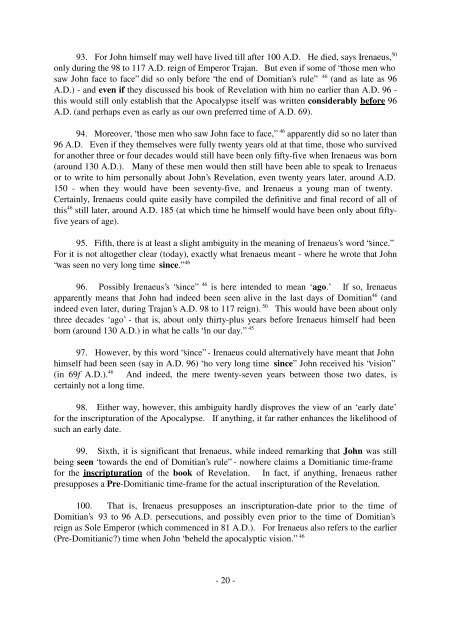JERUSALEM; ROME; REVELATION - The Preterist Archive
JERUSALEM; ROME; REVELATION - The Preterist Archive
JERUSALEM; ROME; REVELATION - The Preterist Archive
Create successful ePaper yourself
Turn your PDF publications into a flip-book with our unique Google optimized e-Paper software.
93. For John himself may well have lived till after 100 A.D. He died, says Irenaeus, 50<br />
only during the 98 to 117 A.D. reign of Emperor Trajan. But even if some of “those men who<br />
saw John face to face” did so only before “the end of Domitian’s rule” 46 (and as late as 96<br />
A.D.) - and even if they discussed his book of Revelation with him no earlier than A.D. 96 -<br />
this would still only establish that the Apocalypse itself was written considerably before 96<br />
A.D. (and perhaps even as early as our own preferred time of A.D. 69).<br />
94. Moreover, “those men who saw John face to face,” 46 apparently did so no later than<br />
96 A.D. Even if they themselves were fully twenty years old at that time, those who survived<br />
for another three or four decades would still have been only fifty-five when Irenaeus was born<br />
(around 130 A.D.). Many of these men would then still have been able to speak to Irenaeus<br />
or to write to him personally about John’s Revelation, even twenty years later, around A.D.<br />
150 - when they would have been seventy-five, and Irenaeus a young man of twenty.<br />
Certainly, Irenaeus could quite easily have compiled the definitive and final record of all of<br />
this 46 still later, around A.D. 185 (at which time he himself would have been only about fiftyfive<br />
years of age).<br />
95. Fifth, there is at least a slight ambiguity in the meaning of Irenaeus’s word “since.”<br />
For it is not altogether clear (today), exactly what Irenaeus meant - where he wrote that John<br />
“was seen no very long time since.” 46<br />
96. Possibly Irenaeus’s “since” 46 is here intended to mean ‘ago.’ If so, Irenaeus<br />
apparently means that John had indeed been seen alive in the last days of Domitian 46 (and<br />
indeed even later, during Trajan’s A.D. 98 to 117 reign). 50 This would have been about only<br />
three decades ‘ago’ - that is, about only thirty-plus years before Irenaeus himself had been<br />
born (around 130 A.D.) in what he calls “in our day.” 45<br />
97. However, by this word “since” - Irenaeus could alternatively have meant that John<br />
himself had been seen (say in A.D. 96) “no very long time since” John received his “vision”<br />
(in 69f A.D.). 46 And indeed, the mere twenty-seven years between those two dates, is<br />
certainly not a long time.<br />
98. Either way, however, this ambiguity hardly disproves the view of an ‘early date’<br />
for the inscripturation of the Apocalypse. If anything, it far rather enhances the likelihood of<br />
such an early date.<br />
99. Sixth, it is significant that Irenaeus, while indeed remarking that John was still<br />
being seen “towards the end of Domitian’s rule” - nowhere claims a Domitianic time-frame<br />
for the inscripturation of the book of Revelation. In fact, if anything, Irenaeus rather<br />
presupposes a Pre-Domitianic time-frame for the actual inscripturation of the Revelation.<br />
100. That is, Irenaeus presupposes an inscripturation-date prior to the time of<br />
Domitian’s 93 to 96 A.D. persecutions, and possibly even prior to the time of Domitian’s<br />
reign as Sole Emperor (which commenced in 81 A.D.). For Irenaeus also refers to the earlier<br />
(Pre-Domitianic?) time when John “beheld the apocalyptic vision.” 46<br />
- 20 -
















